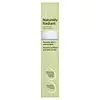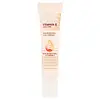What's inside
What's inside
 Key Ingredients
Key Ingredients

 Benefits
Benefits

 Concerns
Concerns

 Ingredients Side-by-side
Ingredients Side-by-side

Water
Skin ConditioningGlycerin
HumectantParaffinum Liquidum
EmollientButyrospermum Parkii Butter
Skin ConditioningOctyldodecanol
EmollientGlyceryl Stearate Se
EmulsifyingDimethicone
EmollientIsohexadecane
EmollientPolyglyceryl-3 Methylglucose Distearate
EmulsifyingBetaine
HumectantStearyl Alcohol
EmollientStearic Acid
CleansingSaccharomyces Cerevisiae Extract
Skin ConditioningRhodiola Rosea Root Extract
EmollientSapindus Mukorossi Fruit Extract
Skin ConditioningCaesalpinia Spinosa Gum
Skin ConditioningActinidia Chinensis Fruit Extract
EmollientNelumbium Speciosum Flower Extract
Skin ConditioningMorus Nigra Leaf Extract
Skin ConditioningTocopheryl Acetate
AntioxidantLecithin
EmollientTocopherol
AntioxidantAscorbyl Palmitate
AntioxidantPentylene Glycol
Skin ConditioningPhenoxyethanol
PreservativeEthylhexylglycerin
Skin ConditioningPotassium Sorbate
PreservativeSodium Benzoate
MaskingCarbomer
Emulsion StabilisingXanthan Gum
Emulsifying2-Bromo-2-Nitropropane-1,3-Diol
PreservativeSodium Hydroxide
BufferingCitric Acid
BufferingDisodium EDTA
Water, Glycerin, Paraffinum Liquidum, Butyrospermum Parkii Butter, Octyldodecanol, Glyceryl Stearate Se, Dimethicone, Isohexadecane, Polyglyceryl-3 Methylglucose Distearate, Betaine, Stearyl Alcohol, Stearic Acid, Saccharomyces Cerevisiae Extract, Rhodiola Rosea Root Extract, Sapindus Mukorossi Fruit Extract, Caesalpinia Spinosa Gum, Actinidia Chinensis Fruit Extract, Nelumbium Speciosum Flower Extract, Morus Nigra Leaf Extract, Tocopheryl Acetate, Lecithin, Tocopherol, Ascorbyl Palmitate, Pentylene Glycol, Phenoxyethanol, Ethylhexylglycerin, Potassium Sorbate, Sodium Benzoate, Carbomer, Xanthan Gum, 2-Bromo-2-Nitropropane-1,3-Diol, Sodium Hydroxide, Citric Acid, Disodium EDTA
Water
Skin ConditioningIsopropyl Palmitate
EmollientGlycerin
HumectantCetearyl Alcohol
EmollientArachidyl Alcohol
EmollientBetaine
HumectantCyclopentasiloxane
EmollientBehenyl Alcohol
EmollientCyclohexasiloxane
EmollientHydrogenated Polydecene
EmollientSaccharomyces Cerevisiae Extract
Skin ConditioningRhodiola Rosea Root Extract
EmollientAesculus Hippocastanum Seed Extract
Skin ConditioningRetinyl Palmitate
Skin ConditioningInositol
HumectantCalcium Pantothenate
Linoleic Acid
CleansingBiotin
AntiseborrhoeicTocopheryl Acetate
AntioxidantTocopherol
AntioxidantAluminum Starch Octenylsuccinate
AbsorbentLauroyl Lysine
Skin ConditioningHydroxyethyl Acrylate/Sodium Acryloyldimethyl Taurate Copolymer
Emulsion StabilisingSqualane
EmollientPolysorbate 60
EmulsifyingButylene Glycol
HumectantPentylene Glycol
Skin ConditioningXanthan Gum
EmulsifyingArachidyl Glucoside
EmulsifyingAlcohol Denat.
AntimicrobialPEG-35 Castor Oil
EmulsifyingPolysorbate 20
EmulsifyingPhenoxyethanol
PreservativeEthylhexylglycerin
Skin ConditioningPotassium Hydroxide
BufferingCitric Acid
BufferingDisodium EDTA
Water, Isopropyl Palmitate, Glycerin, Cetearyl Alcohol, Arachidyl Alcohol, Betaine, Cyclopentasiloxane, Behenyl Alcohol, Cyclohexasiloxane, Hydrogenated Polydecene, Saccharomyces Cerevisiae Extract, Rhodiola Rosea Root Extract, Aesculus Hippocastanum Seed Extract, Retinyl Palmitate, Inositol, Calcium Pantothenate, Linoleic Acid, Biotin, Tocopheryl Acetate, Tocopherol, Aluminum Starch Octenylsuccinate, Lauroyl Lysine, Hydroxyethyl Acrylate/Sodium Acryloyldimethyl Taurate Copolymer, Squalane, Polysorbate 60, Butylene Glycol, Pentylene Glycol, Xanthan Gum, Arachidyl Glucoside, Alcohol Denat., PEG-35 Castor Oil, Polysorbate 20, Phenoxyethanol, Ethylhexylglycerin, Potassium Hydroxide, Citric Acid, Disodium EDTA
Ingredients Explained
These ingredients are found in both products.
Ingredients higher up in an ingredient list are typically present in a larger amount.
Betaine is a common humectant (a substance that promotes retention of moisture). It's known to be gentle on the skin and can help balance hydration.
This ingredient is best for improving hydration and soothing irritated skin. Studies also show it helps even out skin tone.
Fun fact: Betaine is naturally created in the skin and body. The kind found within cosmetic products can be either plant-derived or synthetic.
Another name for betaine is trimethylglycine.
Learn more about BetaineCitric Acid is an alpha hydroxy acid (AHA) naturally found in citrus fruits like oranges, lemons, and limes.
Like other AHAs, citric acid can exfoliate skin by breaking down the bonds that hold dead skin cells together. This helps reveal smoother and brighter skin underneath.
However, this exfoliating effect only happens at high concentrations (20%) which can be hard to find in cosmetic products.
Due to this, citric acid is usually included in small amounts as a pH adjuster. This helps keep products slightly more acidic and compatible with skin's natural pH.
In skincare formulas, citric acid can:
While it can provide some skin benefits, research shows lactic acid and glycolic acid are generally more effective and less irritating exfoliants.
Most citric acid used in skincare today is made by fermenting sugars (usually from molasses). This synthetic version is identical to the natural citrus form but easier to stabilize and use in formulations.
Read more about some other popular AHA's here:
Learn more about Citric AcidDisodium EDTA plays a role in making products more stable by aiding other preservatives.
It is a chelating agent, meaning it neutralizes metal ions that may be found in a product.
Disodium EDTA is a salt of edetic acid and is found to be safe in cosmetic ingredients.
Learn more about Disodium EDTAEthylhexylglycerin (we can't pronounce this either) is commonly used as a preservative and skin softener. It is derived from glyceryl.
You might see Ethylhexylglycerin often paired with other preservatives such as phenoxyethanol. Ethylhexylglycerin has been found to increase the effectiveness of these other preservatives.
Glycerin is already naturally found in your skin. It helps moisturize and protect your skin.
A study from 2016 found glycerin to be more effective as a humectant than AHAs and hyaluronic acid.
As a humectant, it helps the skin stay hydrated by pulling moisture to your skin. The low molecular weight of glycerin allows it to pull moisture into the deeper layers of your skin.
Hydrated skin improves your skin barrier; Your skin barrier helps protect against irritants and bacteria.
Glycerin has also been found to have antimicrobial and antiviral properties. Due to these properties, glycerin is often used in wound and burn treatments.
In cosmetics, glycerin is usually derived from plants such as soybean or palm. However, it can also be sourced from animals, such as tallow or animal fat.
This ingredient is organic, colorless, odorless, and non-toxic.
Glycerin is the name for this ingredient in American English. British English uses Glycerol/Glycerine.
Learn more about GlycerinPentylene glycol is typically used within a product to thicken it. It also adds a smooth, soft, and moisturizing feel to the product. It is naturally found in plants such as sugar beets.
The hydrophilic trait of Pentylene Glycol makes it a humectant. As a humectant, Pentylene Glycol helps draw moisture from the air to your skin. This can help keep your skin hydrated.
This property also makes Pentylene Glycol a great texture enhancer. It can also help thicken or stabilize a product.
Pentylene Glycol also acts as a mild preservative and helps to keep a product microbe-free.
Some people may experience mild eye and skin irritation from Pentylene Glycol. We always recommend speaking with a professional about using this ingredient in your routine.
Pentylene Glycol has a low molecular weight and is part of the 1,2-glycol family.
Learn more about Pentylene GlycolPhenoxyethanol is a preservative that has germicide, antimicrobial, and aromatic properties. Studies show that phenoxyethanol can prevent microbial growth. By itself, it has a scent that is similar to that of a rose.
It's often used in formulations along with Caprylyl Glycol to preserve the shelf life of products.
We don't have a description for Rhodiola Rosea Root Extract yet.
Saccharomyces Cerevisiae Extract comes from a yeast used in fermentation. It has skin conditioning properties due to its naturally occurring peptides, polysaccharides (including beta-glucans), amino acids, minerals, and vitamins.
Clinical research shows formulas that contain this ingredient can improve moisture levels and refine skin texture over time. This is associate with its ability to reduce free-radical activity and protect the skin against environmental damage.
Lab studies demonstrate that some peptide fractions in this ingredient possess antioxidant and anti-collegenase effects, helping to protect the structural proteins in skin and soothing inflammation.
Additionally, this ingredient has been shown to have antimicrobial effects against bacteria associated with acne.
Learn more about Saccharomyces Cerevisiae ExtractTocopherol (also known as Vitamin E) is a common antioxidant used to help protect the skin from free-radicals and strengthen the skin barrier. It's also fat soluble - this means our skin is great at absorbing it.
Vitamin E also helps keep your natural skin lipids healthy. Your lipid skin barrier naturally consists of lipids, ceramides, and fatty acids. Vitamin E offers extra protection for your skin’s lipid barrier, keeping your skin healthy and nourished.
Another benefit is a bit of UV protection. Vitamin E helps reduce the damage caused by UVB rays. (It should not replace your sunscreen). Combining it with Vitamin C can decrease sunburned cells and hyperpigmentation after UV exposure.
You might have noticed Vitamin E + C often paired together. This is because it is great at stabilizing Vitamin C. Using the two together helps increase the effectiveness of both ingredients.
There are often claims that Vitamin E can reduce/prevent scarring, but these claims haven't been confirmed by scientific research.
Learn more about TocopherolTocopheryl Acetate is AKA Vitamin E. It is an antioxidant and protects your skin from free radicals. Free radicals damage the skin by breaking down collagen.
One study found using Tocopheryl Acetate with Vitamin C decreased the number of sunburned cells.
Tocopheryl Acetate is commonly found in both skincare and dietary supplements.
Learn more about Tocopheryl AcetateWater. It's the most common cosmetic ingredient of all. You'll usually see it at the top of ingredient lists, meaning that it makes up the largest part of the product.
So why is it so popular? Water most often acts as a solvent - this means that it helps dissolve other ingredients into the formulation.
You'll also recognize water as that liquid we all need to stay alive. If you see this, drink a glass of water. Stay hydrated!
Learn more about WaterXanthan gum is used as a stabilizer and thickener within cosmetic products. It helps give products a sticky, thick feeling - preventing them from being too runny.
On the technical side of things, xanthan gum is a polysaccharide - a combination consisting of multiple sugar molecules bonded together.
Xanthan gum is a pretty common and great ingredient. It is a natural, non-toxic, non-irritating ingredient that is also commonly used in food products.
Learn more about Xanthan Gum